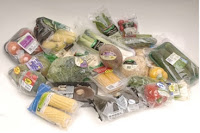I would like to begin by stating I am specifically writing about produce and not canned or jarred foods. For example jars of peanut butter that say
"All Natural" is not what I'm referring to. That subject has enough information on its own for a completely separate blog.
 |
| MAP Packaging |
I want to look at the difference between organically grown and naturally grown. The misconception (even by some health professionals) is if the word organic is spoken or written than you are getting the absolute best no matter where it comes from. The truth is there is no difference in naturally and organically grown when it comes to growing, fertilizing, and using pesticides. The difference is that naturally grown farmers are your local farmers. Naturally grown farms must still adhere to the very strict and growing guidelines of the USDA. Certified Naturally Grown farms is basically the grassroots of the USDA Certified Organic. The only difference is money. We all know that buying locally can keep spending down, so this is good for us as consumers. Quality fresh produce without the markup is a good situation. Now, moving on to the really important part. What is the difference when shopping in grocery stores rather than farmers markets or farms?
 |
| More MAP Packaging |
For the most part you are only going to find produce labeled
"organic" in grocery stores and club stores. Rarely do you find produce that reads
"naturally grown" unless you shop at a farmers market. You can rest assured that whether organic or naturally grown it was grown in high quality soil and most likely this particular piece of food was not victim to synthetic pesticides. So far so good. Now for the red flag, the
"pre-washed" and bagged romaine lettuce that you may have in your fridge will often last for 3 weeks or longer! Something about that seems unnatural. Here's where the good ole FDA gets you; they have approved what they call Modified Atmosphere Packaging or MAP. Their MAP includes packaging that is not only
"smart" but
"edible", and was created to
"greatly improve the quality and shelf-stability" of produce. This is basically a displacement of gases in the package that contains the food which are then replaced by
"desired mixture of gases". Now this process reduces the rate of respiration by limiting dioxygen therefore delaying the oxidative breakdown of complex substrates that the product is made up of. Simplified, this process of modifying the atmosphere of the package keeps the food from ripening or maturing at its natural rate. In doing this the food often doesn't show signs we would normally look for to determine if it's time to throw it out or not. It keeps shape longer and has little to no odor. The FDA even released a statement that the process of MAP has been the cause of many cases of food poisoning because the consumer has no signs that the food has already spoiled. The process of MAP increases the growth potential for
"foodborne pathogens". Maybe it just makes sense to save some money and get a good bargain, but lets look at it from a different perspective. How much money are we really saving if we get food poisoning from a bargain priced bag of produce that was touched with MAP? If you have ever had food poisoning you know that it is painful, uncomfortable, and you more than likely are going to miss work. After missing a day or two of work, maybe seeing a doctor, and perhaps buying some disinfectant for home or mouthwash for post vomiting it is probably safe to say the produce that came in a
"modified atmosphere" costs more than it actually saved.
 |
| Spinach |
In fact, don't take my word for it, please go into Costco or Sam's Club and buy a bag of spinach or Romaine lettuce. Take it home, write the date on it, and see how long it stays it's "good" for. Then just leave it in the fridge to see how long it lasts and keeps that edible look. Although we can get a great deal on organic, pre-washed, and pre-packaged food like lettuce or spinach we need to also realize that we are most likely getting more than we bargained for. So many extra additives are included by extending the shelf life of foods that were never intended to last more than a few days. Hopefully this information will be enough to nudge some of you into reconsidering what you buy for your families. I know that after I learned about this I couldn't stand the thought of putting this on my child's plate. Many steps and
"advancements" are being taken by offices and administrations to
"improve" our food system, and as consumers we should know all the facts so that we can make informed decisions.
The Next Abundant Living blog will be packed full of information regarding the foods we eat that are treated with irradiation. Please check back before your next grocery trip.





